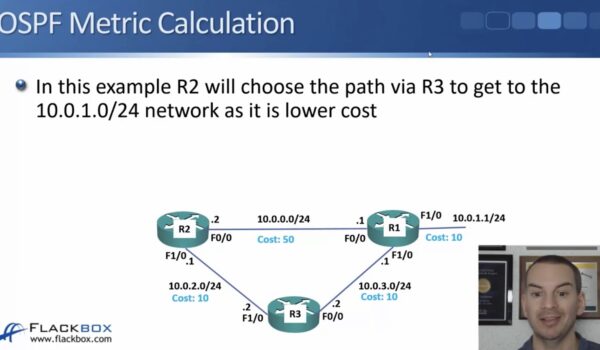Open Shortest Path First is a dynamic routing protocol widely used in computer networks to determine the most efficient path for data packets to travel from a source to a destination. The foundation of decision-making lies in its cost metrics. These metrics are essential for routers to calculate the best path among multiple routes.
At its core, OSPF assigns a cost value to each link or interface in the network. This cost value represents the relative expense of using that link to reach a specific destination. Lower cost values indicate a more favorable path. Its routers use these cost metrics to build a routing table that guides data traffic. Let’s delve into some key aspects of this cost metrics:
- Bandwidth-Based Metrics: It primarily calculates cost based on the bandwidth of the network interfaces. Interfaces with higher bandwidth are assigned lower cost values, as they can handle more traffic efficiently. This makes it inherently prefer high-speed links when determining routes;
- Cumulative Costs: To determine the best path to a destination network, it sums up the individual interface costs along the route. This cumulative cost represents the overall expense of using that route. It will select the route with the lowest cumulative cost as the optimal path;
- Default Cost Values: Different routers may use varying default cost values for different types of interfaces.
Understanding these cost metrics is crucial for network administrators when configuring, as it allows them to influence the route selection process to align with network performance goals.
Open Shortest Path First’s utilization of cost metrics, primarily based on interface bandwidth, is fundamental in determining optimal routes for network traffic. These metrics enable routers to make informed decisions and efficiently direct data packets across complex network topologies. By carefully configuring cost values, network administrators can fine-tune routing to meet specific requirements, whether it’s prioritizing speed, redundancy, or other factors, ultimately ensuring robust and efficient network operation.
Furthermore, it dynamically recalculates its routing tables in response to changes in network conditions. If an interface’s bandwidth changes, OSPF automatically adjusts the cost metric, allowing for real-time adaptation to network alterations. This dynamic nature ensures that this First-based networks remain responsive and capable of quickly rerouting traffic in case of link failures or congestion, enhancing overall network reliability and resilience.
Calculating OSPF Cost
In routing, the cost metric is a fundamental concept used to determine the best path for routing traffic through a network. The formula, Cost = 100 / Interface Bandwidth in Mbps, is at the core of this process. This formula means that interfaces with higher bandwidth values will have lower OSPF costs, indicating they are more favorable for routing.
Understanding Open Shortest Path First cost calculations is essential for network administrators and engineers as it influences how it routers make routing decisions, ensuring efficient and reliable data transmission across complex networks.
To wrap up
In conclusion, this article has provided a comprehensive overview of the OSPF routing protocol, with a specific focus on the critical aspect of cost metrics. It began by emphasizing the importance of understanding fundamentals and routing configuration as prerequisites for delving into cost metrics.
The article then elucidated how it uses cost metrics, derived from interface bandwidth, to determine optimal paths for network traffic. These cost metrics play a pivotal role in OSPF’s decision-making process, allowing routers to select the most efficient routes based on available bandwidth. This not only aids in maximizing network performance but also contributes to load balancing and fault tolerance.
Moreover, OSPF’s dynamic nature, wherein cost metrics adapt to changing network conditions, was highlighted as a key feature for ensuring network resilience. By continuously recalculating routing tables, it can respond swiftly to link failures or shifts in bandwidth, thereby maintaining consistent and efficient data transmission.
